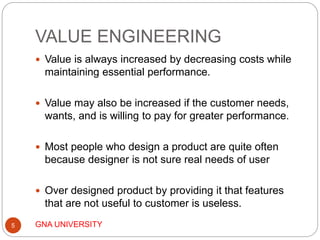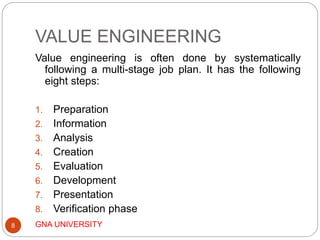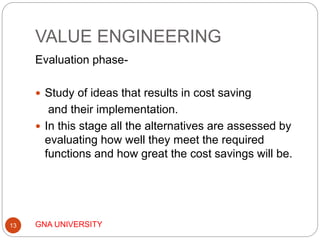VALUE ENGINEERING ANALYSIS PPT
- 1. GNA UNIVERSITY1 PRESENTATION BY Rocky Sharma GU-2015-0315 M.Tech Mechanical ER. RAHUL JOSHI
- 2. VALUE ENGINEERING GNA UNIVERSITY2 Value, as defined, is the ratio of function to cost. Value engineering (VE) is systematic method to improve the "value" of goods or products and services by using an examination of function.
- 3. VALUE ENGINEERING GNA UNIVERSITY3 Value Engineering is an organizational creative approach for the purpose of identifying of unnecessary cost. Unnecessary cost are that which provides neither quality, nor use, not appearance, not life and customer features.
- 4. VALUE ENGINEERING GNA UNIVERSITY4 It includes – 1. Cost Cutting 2. Design Review 3. Project Elimination 4. Scope Reduction 5. Quality Reduction 6. Detailed Cost Estimating 7. Redesign
- 5. VALUE ENGINEERING GNA UNIVERSITY5 Value is always increased by decreasing costs while maintaining essential performance. Value may also be increased if the customer needs, wants, and is willing to pay for greater performance. Most people who design a product are quite often because designer is not sure real needs of user Over designed product by providing it that features that are not useful to customer is useless.
- 6. VALUE ENGINEERING GNA UNIVERSITY6 The value of a function is defined as the relationship of cost to performance Performance max Cost min Value max =
- 7. VALUE ENGINEERING GNA UNIVERSITY7 VE applies to everything because every project or process has a function VE can be applied at any point of the design or process VE is a problem solving technique VE can be used as a technique for developing design criteria
- 8. VALUE ENGINEERING GNA UNIVERSITY8 Value engineering is often done by systematically following a multi-stage job plan. It has the following eight steps: 1. Preparation 2. Information 3. Analysis 4. Creation 5. Evaluation 6. Development 7. Presentation 8. Verification phase
- 9. VALUE ENGINEERING GNA UNIVERSITY9 Preparation- It is the most important phase of value engineering that creates that right and successful environment. In this phase there is interaction of customer before manufacturing. Work done on specifics rather than on generalities.
- 10. VALUE ENGINEERING GNA UNIVERSITY10 Information phase- To determine user needs To build team knowledge and understanding of the project To completely understand the specific use of function requirements of the item To visit the site (preferable) Process continues throughout remainder of the study
- 11. VALUE ENGINEERING GNA UNIVERSITY11 Analysis phase- The evaluation should be done after each idea after brainstorming. Analyzing of each ideas without thinking that idea would not work, idea not possible and all that. Identification of barriers and their elimination tactfully.
- 12. VALUE ENGINEERING GNA UNIVERSITY12 Creation- In this stage value engineers ask; What are the various alternative ways of meeting requirements? What else will perform the desired function? Brainstorming with positive thinking. Creative ideas can be developed by number of check lists.
- 13. VALUE ENGINEERING GNA UNIVERSITY13 Evaluation phase- Study of ideas that results in cost saving and their implementation. In this stage all the alternatives are assessed by evaluating how well they meet the required functions and how great the cost savings will be.
- 14. VALUE ENGINEERING GNA UNIVERSITY14 Development phase- This phase attempts a further development of the two to four ideas selected earlier. A real effort to develop the ideas of lowest cost that do the main function is attempted. Ask yourself: would I spent my own money on this solution? If not modify it.
- 15. VALUE ENGINEERING GNA UNIVERSITY15 Presentation – In the final stage, the best alternative will be chosen and presented to the client for final decision To present value engineering study proposals to the decision makers/stake holders To obtain approval/support Present final solution in writing in concise format stating the savings cost and detailed plan for implementation the idea.
- 16. VALUE ENGINEERING GNA UNIVERSITY16 Verification phase- Every step of the process is geared towards obtaining a result that increases the rate on investment. It is necessary to ensure that the group that implements the idea inform of savings produced and other benefits.
- 17. VALUE ENGINEERING GNA UNIVERSITY17 Conclusion- Value Engineering helps us to learn how to : Improve our career skills Separate "Symptoms" from "problems" Solve "root cause" problems and capture opportunities Become more competitive by improving "benchmarking" process Take command of a powerful problem solving methodology to use in any situation Reduction in cost of existing products or systems. Prevention of unnecessary cost in new products .

















